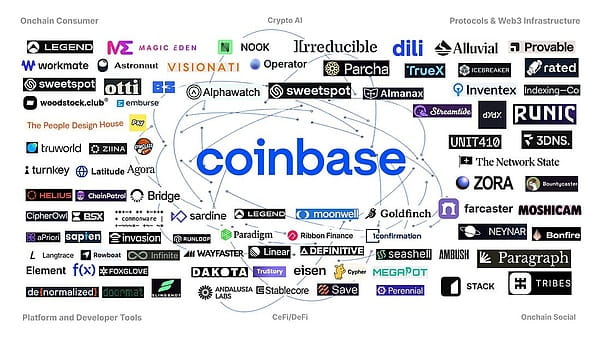Author: Jay Jo, Research Analyst at Tiger Research; Translation: Xiaozou from Golden Finance
Coinbase is transforming; it is no longer just an exchange but is building a full-stack cryptocurrency ecosystem through Base chain and The Base application.
The company simultaneously emulates Google's model by acquiring several cryptocurrency startups and leveraging a strong Coinbase 'alumni' network to extend its influence across the entire cryptocurrency industry.
Coinbase's strategic moves will undoubtedly drive the popularization of the cryptocurrency industry. However, this has also created a new centralized structure, leaving the challenge of how to maintain a balance with decentralized values.
1. Coinbase: Ambitions Beyond an Exchange
In April 2021, Coinbase became the first cryptocurrency exchange to go public on a stock exchange. The company was listed on Nasdaq via a direct listing. This was not just an IPO for a company but a landmark turning point, signaling that the cryptocurrency industry had officially entered the mainstream financial system.

The company's name is also symbolic. 'Coinbase' originates from the 'Coinbase transaction' in Bitcoin — referring to the first transaction recorded when creating a new block, representing the moment of cryptocurrency's birth. This name reflects the company's strong commitment to being the starting point of the cryptocurrency ecosystem.
The symbolic significance of Coinbase is not limited to its name. The company continuously expands its scope of operations based on its exchange business and is now building a vast ecosystem. Its launch of the Ethereum L2 Base and the recent release of The Base App (TBA) at the 'A New Day One' event both indicate that Coinbase is creating a full-stack cryptocurrency ecosystem from infrastructure to application layer.
This article will analyze how Coinbase has developed from an exchange into an empire covering the entire cryptocurrency ecosystem and explore the significance of these changes for the industry.
2. A Full-Stack Crypto Ecosystem: Exchanges, Infrastructure, and Consumer Applications
2.1 Exchanges: Coinbase's Reliable Cash Cow
Coinbase's core business is undoubtedly its exchange. The company provides cryptocurrency trading services to various users, from individuals to institutions, generating revenue through trading fees. As of 2024, trading fee income accounts for about 60% of total revenue, reaching approximately $4 billion. Relatively stable trading fee income has become the foundation for Coinbase to develop new businesses, similar to how Amazon uses AWS as a cash cow to diversify its business.

In addition, the value of exchanges is also reflected in their strategic expansibility. As the core entry and exit channel connecting fiat and cryptocurrency, exchanges have gained a large user base and trading data thanks to this position. Based on this foundation, they serve as a strategic hub, naturally guiding users into a broader ecosystem. Exchanges not only provide Coinbase with financial stability but also grant it strategic expansibility, becoming the cornerstone of ecosystem development.
2.2 Base Chain: A Strategic Leap from Off-Chain to On-Chain
The Base chain is a layer-2 blockchain built directly by Coinbase based on Ethereum. Through this chain, Coinbase has achieved expansion from exchange operations to the on-chain domain.

This expansion stems from the structural characteristics of the cryptocurrency ecosystem. The cryptocurrency ecosystem is divided into off-chain and on-chain environments. Exchanges primarily provide trading services between fiat currency and cryptocurrency in the off-chain environment.
However, the actual use of cryptocurrency occurs in the on-chain environment outside of Coinbase. This includes scenarios such as collateral lending and governance participation based on cryptocurrency. For example, after purchasing cryptocurrency on Coinbase, users need to transfer it on-chain to participate in specific DeFi protocols. This means that Coinbase faces structural limitations, being forced to funnel users to other ecosystems.
The Base chain resolves these limitations. Now, even if users purchase cryptocurrency on Coinbase and withdraw it, they can still remain within the Coinbase ecosystem. Just as Apple controls both hardware and software, Coinbase can now manage the complete user flow from exchanges to infrastructure. This strategy is of great significance.
2.3 TBA: The Final Piece of the Crypto Ecosystem Puzzle

In July 2025, Coinbase announced the launch of the on-chain super application TBA, moving toward a grander vision. This strategy is not limited to acquiring users through the exchange but aims to provide users with directly usable application layers through Base infrastructure. Although there are numerous dApps based on Base, they are scattered and difficult to integrate. Regardless of how excellent the performance of the Base chain or how low the costs, if ordinary users cannot easily access it, these would struggle to generate real value.

TBA integrates the core elements of the crypto ecosystem — exchanges, infrastructure, and applications — into a single platform, providing a seamless user experience. Users can make cryptocurrency payments and transfers, as well as earn through Farcaster's social service, and immediately use it for online and offline payments, creating a brand-new on-chain experience. Multiple services synergize to form a powerful force, jointly building a vast on-chain economic ecosystem. As a result, the threshold for participating in the on-chain economy has been significantly lowered. This marks the completion of the last piece of the grand ecosystem that Coinbase has been building.
3. Coinbase Builds a Crypto Empire
Coinbase is no longer just an exchange. The company has built blockchain infrastructure and consumer applications based on its exchange business, ultimately developing into a vast empire covering the entire cryptocurrency ecosystem. Moreover, through aggressive acquisition strategies, its business landscape is expanding into more diverse fields — including the acquisition of token management platform LiquiFi, zero-knowledge proof technology company Iron Fish, Web3 advertising platform Spindl, and cryptocurrency derivatives exchange Deribit, extending its reach into various corners of the Web3 industry.

These actions resemble an aircraft carrier strategy aimed at controlling all touchpoints in the cryptocurrency market. Its relationship with Circle, the issuer of the stablecoin USDC, is even more noteworthy: Coinbase is not only a major shareholder in Circle but can also receive a certain proportion of USDC interest income beyond equity investment. The agreement even stipulates that if Circle goes bankrupt or fails to fulfill its profit distribution obligations, part of the USDC-related rights will be transferred to Coinbase. This shows that Coinbase almost controls the core infrastructure across various fields of the cryptocurrency ecosystem.

Coinbase's expansion strategy is not solely achieved through mergers and acquisitions. Another core strategy is to let the Coinbase 'alumni' network permeate the entire cryptocurrency industry, much like the 'PayPal Mafia' did in its time. The company has invested in over 40 Web3 startups founded by former Coinbase employees and continues to build a close collaboration network through partnerships. Notable examples include Polychain Capital, founded by Coinbase's first employee Olaf Carlson-Wee, and well-known Web3 projects like dYdX, Farcaster, Zora, and B3, all founded by Coinbase alumni.
We still view Coinbase as an exchange, but its actual operational model is more akin to Google in the Web2 era. Just as Google started with search services and eventually dominated the entire digital realm, including advertising, cloud computing, and mobile ecosystems, Coinbase similarly began with its exchange operations and has built a vast empire covering the entire cryptocurrency ecosystem.
4. The Exchange-Centric Crypto Market: Benefit or Harm?
Coinbase is building a vast empire. The company's development path from exchanges to the Base chain and then to TBA has clear strategic intentions. However, within this aggressive expansion strategy, we need to examine its industry positioning.
Cryptocurrencies once held high the banner of decentralization, yet today they have returned to centralization in the pursuit of convenience. Once users voluntarily enter the Coinbase ecosystem, they often cannot find a reason to leave — this is essentially no different from traditional financial structures.
This transformation is not entirely negative. Integrated platforms like TBA indeed provide real benefits to users: no need for complex wallet connections, eliminating the hassle of switching between platforms, and no worries about high gas fees, allowing users to access all services within a single application. From earning through social activities to completing payments, the entire process is seamlessly connected. Coinbase's model clearly promotes the popularization of cryptocurrencies.
However, a key issue cannot be ignored: cryptocurrencies were born from decentralization, yet today they have given rise to new centralized structures due to convenience. Users voluntarily remain in the Coinbase ecosystem and lack the motivation to migrate, which is fundamentally no different from the traditional centralized financial system we seek to disrupt.
The market has already chosen convenience, making it challenging to reverse this trend. The urgent task is to find a balance between centralized convenience and decentralized spirit. The real challenge lies in how to build an ecosystem that ensures user choice while maintaining the core values of cryptocurrencies through healthy competition and continuous innovation.



